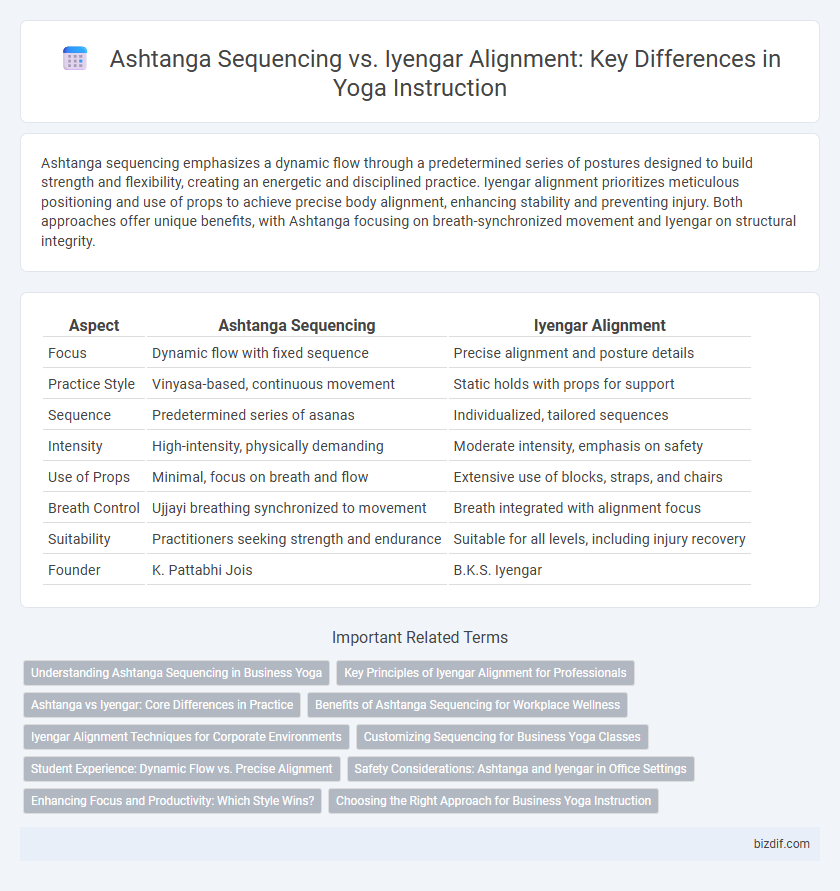Ashtanga sequencing emphasizes a dynamic flow through a predetermined series of postures designed to build strength and flexibility, creating an energetic and disciplined practice. Iyengar alignment prioritizes meticulous positioning and use of props to achieve precise body alignment, enhancing stability and preventing injury. Both approaches offer unique benefits, with Ashtanga focusing on breath-synchronized movement and Iyengar on structural integrity.
Table of Comparison
| Aspect | Ashtanga Sequencing | Iyengar Alignment |
|---|---|---|
| Focus | Dynamic flow with fixed sequence | Precise alignment and posture details |
| Practice Style | Vinyasa-based, continuous movement | Static holds with props for support |
| Sequence | Predetermined series of asanas | Individualized, tailored sequences |
| Intensity | High-intensity, physically demanding | Moderate intensity, emphasis on safety |
| Use of Props | Minimal, focus on breath and flow | Extensive use of blocks, straps, and chairs |
| Breath Control | Ujjayi breathing synchronized to movement | Breath integrated with alignment focus |
| Suitability | Practitioners seeking strength and endurance | Suitable for all levels, including injury recovery |
| Founder | K. Pattabhi Jois | B.K.S. Iyengar |
Understanding Ashtanga Sequencing in Business Yoga
Understanding Ashtanga sequencing in business yoga enhances practice efficiency by promoting a dynamic flow of postures that build strength and flexibility systematically. This method prioritizes a fixed order of asanas, enabling practitioners to develop muscle memory and stamina, which can improve focus and reduce stress in a corporate environment. Unlike Iyengar alignment, which emphasizes precision and use of props, Ashtanga sequencing supports continuous movement, making it ideal for time-conscious business professionals seeking a vigorous yet structured yoga practice.
Key Principles of Iyengar Alignment for Professionals
Iyengar alignment emphasizes precise anatomical positioning and the use of props to ensure proper form and prevent injury, making it essential for yoga professionals seeking depth in practice. Core principles include maintaining correct joint alignment, achieving symmetry, and sustaining balance between strength and flexibility in each posture. Mastery of these elements supports safe progression and enhances the therapeutic benefits of Iyengar yoga instruction.
Ashtanga vs Iyengar: Core Differences in Practice
Ashtanga yoga emphasizes a dynamic, flowing sequence of postures linked by breath, promoting strength, flexibility, and endurance through a set vinyasa series. Iyengar yoga prioritizes precise alignment, use of props, and prolonged holds to ensure structural integrity and deepen body awareness, often catering to therapeutic needs. The core difference lies in Ashtanga's rhythmic, vigorous flow versus Iyengar's meticulous focus on posture accuracy and individualized adjustment.
Benefits of Ashtanga Sequencing for Workplace Wellness
Ashtanga sequencing promotes a dynamic flow of postures that enhances cardiovascular health and boosts energy levels, making it ideal for workplace wellness programs aimed at reducing stress and improving productivity. The structured progression of Ashtanga supports mental clarity and focus through synchronized breath and movement, helping employees sustain concentration during demanding work hours. Regular practice cultivates resilience and physical endurance, contributing to overall employee well-being and reduced absenteeism.
Iyengar Alignment Techniques for Corporate Environments
Iyengar alignment techniques prioritize precise body positioning and use of props like blocks and straps to ensure safe, effective practice, which reduces injury risks in corporate environments. These methods enhance posture correction and improve workplace ergonomics, fostering better focus and productivity among employees. Incorporating Iyengar principles into corporate yoga programs supports long-term musculoskeletal health and stress reduction.
Customizing Sequencing for Business Yoga Classes
Customizing sequencing in business yoga classes involves balancing Ashtanga's dynamic flow with Iyengar's precise alignment to address diverse employee needs. Incorporating Ashtanga sequencing delivers energetic, continuous movement that enhances cardiovascular health and stamina. Meanwhile, Iyengar's alignment-focused approach promotes injury prevention and improved posture, making it ideal for desk-bound workers requiring mindful body mechanics.
Student Experience: Dynamic Flow vs. Precise Alignment
Ashtanga sequencing offers students a dynamic flow that builds strength, stamina, and flexibility through a set series of postures linked by breath, creating a rhythmic, energetic practice. Iyengar alignment emphasizes precise adjustments and the use of props to ensure accurate posture, enhancing body awareness and reducing injury risk. Students often find Ashtanga promotes cardiovascular fitness and fluidity, while Iyengar fosters mindful stability and structural integrity.
Safety Considerations: Ashtanga and Iyengar in Office Settings
Ashtanga sequencing emphasizes dynamic flow and core strength, which can build endurance but may increase risk of repetitive strain injuries in office workers with limited flexibility. Iyengar's focus on precise alignment and use of props promotes joint safety and reduces strain, making it a safer choice for practitioners in office environments needing ergonomic support. Prioritizing Iyengar methods can help prevent posture-related injuries and enhance overall workplace wellness through controlled, mindful movements.
Enhancing Focus and Productivity: Which Style Wins?
Ashtanga sequencing enhances focus by promoting a dynamic flow that requires continuous attention to breath and movement, boosting mental endurance and productivity. Iyengar alignment prioritizes precise posture and mindfulness, fostering deep concentration and body awareness that improve cognitive clarity and task efficiency. For sustained productivity, Iyengar's meticulous alignment techniques may offer superior benefits, while Ashtanga's energetic sequencing excels in cultivating quick focus bursts.
Choosing the Right Approach for Business Yoga Instruction
Ashtanga sequencing emphasizes a dynamic flow of postures performed in a specific order, ideal for clients seeking energetic and physically challenging yoga sessions. Iyengar alignment prioritizes precise postural alignment using props to ensure safety and therapeutic benefits, making it suitable for businesses targeting clients with injuries or mobility issues. Selecting the right approach depends on client demographics and business goals, balancing dynamic flow with structural precision to enhance client satisfaction and retention.
Ashtanga Sequencing vs Iyengar Alignment Infographic

 bizdif.com
bizdif.com